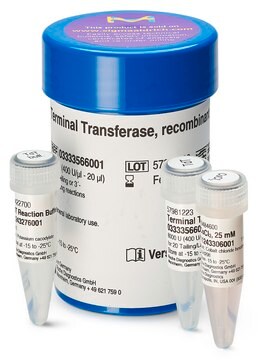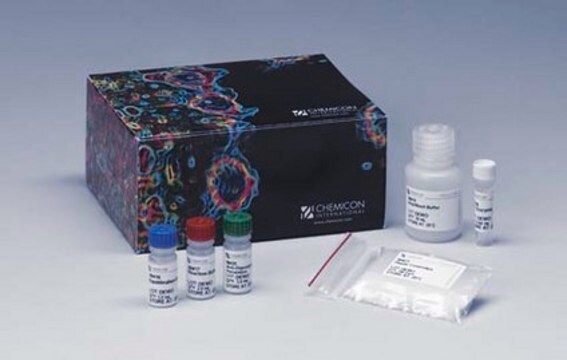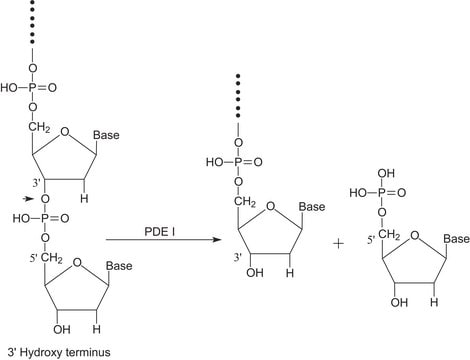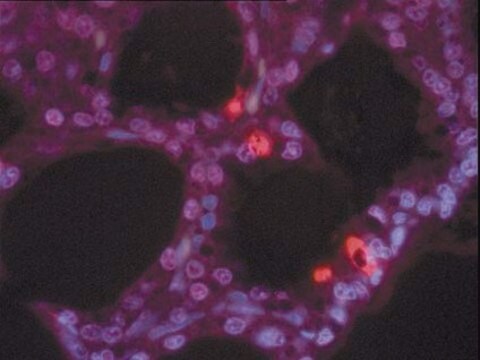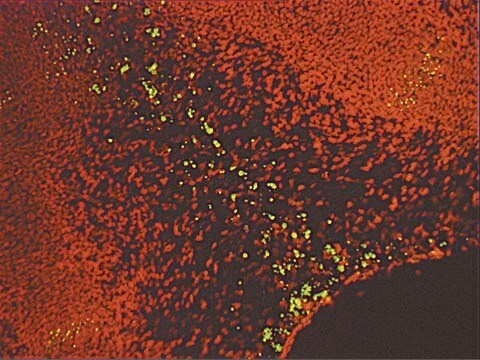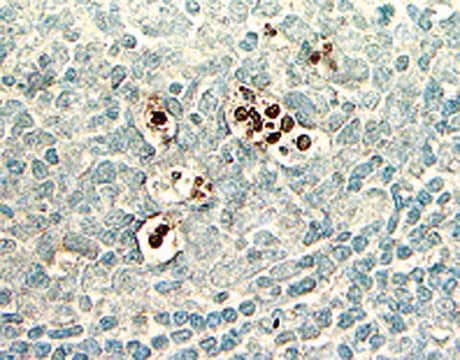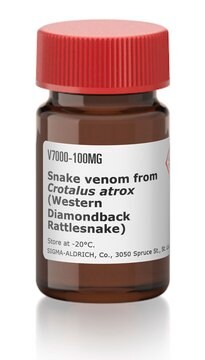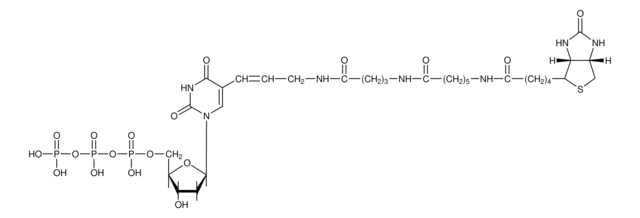S7107
ApopTag TdT Enzyme
ApopTag Terminal deoxynucleotidyl Transferase (TdT) is a recombinant enzyme intended for use in labeling the 3′-OH ends of fragmented DNA during apoptotic cell detection.
Synonim(y):
TdT enzyme, Terminal deoxynucleotidyl transferase
Zaloguj sięWyświetlanie cen organizacyjnych i kontraktowych
About This Item
Kod UNSPSC:
12161503
eCl@ss:
32161000
NACRES:
NA.84
Polecane produkty
Opis ogólny
ApopTag Terminal deoxynucleotidyl Transferase (TdT) is a recombinant enzyme intended for use in labeling the 3′-OH ends of fragmented DNA during apoptotic cell detection. Qualified for use with Apoptag In Situ Apoptosis Detection Kits (Catalog #s: S7100, S7101, S7110, S7111, S7160 and S7165).
ApopTag is a registered trademark of Serologicals Company.
ApopTag is a registered trademark of Serologicals Company.
Zastosowanie
Materials Provided:
Each vial contains 300 μl of ApopTag Terminal Transferase (TdT) Enzyme.
Instructions for Use
Prepare labeling mixture as follows:
77 μl ApopTag Reaction Buffer (S7105 or kit component # 02)
33 μl ApopTag TdT Enzyme
Mix well and keep on ice. This reagent may be prepared in advance and stored on ice for no more than 6 hours. The Reaction Buffer - TdT Enzyme mixture is ready for use at the "APPLY WORKING STRENGTH TdT ENZYME" step in The Complete ApopTag Manual.
Warnings and Precautions :
ApopTag Terminal Transferase (TdT) Enzyme contains potassium cacodylate (dimethylarsinic acid) as a buffer. This material is harmful if swallowed; avoid contact with skin and eyes (wear gloves, glasses); wash areas of contact immediately.
Each vial contains 300 μl of ApopTag Terminal Transferase (TdT) Enzyme.
Instructions for Use
Prepare labeling mixture as follows:
77 μl ApopTag Reaction Buffer (S7105 or kit component # 02)
33 μl ApopTag TdT Enzyme
Mix well and keep on ice. This reagent may be prepared in advance and stored on ice for no more than 6 hours. The Reaction Buffer - TdT Enzyme mixture is ready for use at the "APPLY WORKING STRENGTH TdT ENZYME" step in The Complete ApopTag Manual.
Warnings and Precautions :
ApopTag Terminal Transferase (TdT) Enzyme contains potassium cacodylate (dimethylarsinic acid) as a buffer. This material is harmful if swallowed; avoid contact with skin and eyes (wear gloves, glasses); wash areas of contact immediately.
Opakowanie
1000 units/mL
Przechowywanie i stabilność
Recommended Storage -15°C to -25°C.
Informacje prawne
CHEMICON is a registered trademark of Merck KGaA, Darmstadt, Germany
Oświadczenie o zrzeczeniu się odpowiedzialności
Unless otherwise stated in our catalog or other company documentation accompanying the product(s), our products are intended for research use only and are not to be used for any other purpose, which includes but is not limited to, unauthorized commercial uses, in vitro diagnostic uses, ex vivo or in vivo therapeutic uses or any type of consumption or application to humans or animals.
Ta strona może zawierać tekst przetłumaczony maszynowo.
Hasło ostrzegawcze
Danger
Zwroty wskazujące rodzaj zagrożenia
Zwroty wskazujące środki ostrożności
Klasyfikacja zagrożeń
Aquatic Chronic 2 - Carc. 1B
Kod klasy składowania
6.1C - Combustible acute toxic Cat.3 / toxic compounds or compounds which causing chronic effects
Klasa zagrożenia wodnego (WGK)
WGK 3
Certyfikaty analizy (CoA)
Poszukaj Certyfikaty analizy (CoA), wpisując numer partii/serii produktów. Numery serii i partii można znaleźć na etykiecie produktu po słowach „seria” lub „partia”.
Masz już ten produkt?
Dokumenty związane z niedawno zakupionymi produktami zostały zamieszczone w Bibliotece dokumentów.
Klienci oglądali również te produkty
Po-Nien Tsao et al.
Development (Cambridge, England), 136(13), 2297-2307 (2009-06-09)
Although there is accumulated evidence of a role for Notch in the developing lung, it is still unclear how disruption of Notch signaling affects lung progenitor cell fate and differentiation events in the airway epithelium. To address this issue, we
Divya A Shiroor et al.
Current biology : CB, 30(11), 2166-2174 (2020-05-11)
Stem cells are continuously exposed to multiple stresses, including radiation and tissue injury. As central drivers of tissue repair and regeneration, it is necessary to understand how their behavior is influenced by these stressors. Planarians have an abundant population of
Nasz zespół naukowców ma doświadczenie we wszystkich obszarach badań, w tym w naukach przyrodniczych, materiałoznawstwie, syntezie chemicznej, chromatografii, analityce i wielu innych dziedzinach.
Skontaktuj się z zespołem ds. pomocy technicznej